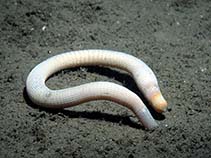Sipunculus nudus Linnaeus, 1766
| Native range | All suitable habitat | Point map | Year 2050 |

|
| This map was computer-generated and has not yet been reviewed. |
| Sipunculus nudus AquaMaps Data sources: GBIF OBIS |
Classification / Names Common names | Synonyms | CoL | ITIS | WoRMS
Sipunculidea | Sipunculiformes | Sipunculidae
Environment: milieu / climate zone / depth range / distribution range Ecology
Benthic; depth range 0 - 2275 m (Ref. 775). Temperate; 15°C - 30°C (Ref. 358); 35°N - (Ref. 358)
Distribution Countries | FAO areas | Ecosystems | Occurrences | Introductions
Indo-West Pacific, North and Central Atlantic, and the Mediterranean. Cosmopolitan. Temperate and subtropical.
Length at first maturity / Size / Weight / Age
Maturity: Lm ? range ? - ? cm Max length : 30.0 cm TL male/unsexed; (Ref. 86591); common length : 1.0 cm male/unsexed; (Ref. 358)
Short description Morphology
Small ones: transparent and iridescent. Large one: pinkish red. Skin is smooth to small ones. Trunk: has no papillae; introvert is covered with triangular "scales" or large white papillae directed posteriorly. Some having 4 lobes - 2 dorsal and 2 ventral. Longitudinal muscle bands (LMBs): thick strong ridges; common 5-15 cm long with 24-34 LMBs. Refractors muscles are separate and attach at the same level, each with a broad base extending over 5 - 7 longitudinal muscle bands. Spindle muscle: attached anterior to the anus. Gut: attached to the body wall by several fixing muscles or connective tissue strands throughout its length; very thin, transparent, and fragile. Nephridia: vary in length; range from 10 to 20% of the trunk length. Nephridiopores: anterior to the anus between the 4th and 5th longitudinal muscle bands. Ventral nerve cord: loosely attached anteriorly with numerous, large, lateral offshoots to the introvert (Ref. 358).
Eulittoral; intertidal and subtidal on mud, rocks, sand, silt and in rock cracks or crevices (Ref. 358 and 1784). Occurs from 12 m (Ref. 358) in the littoral zone to 2275 m (Ref. 775) along continental shelf and slope (Ref. 1456). Predated on by the finfish Diplodus sargus sargus (Ref. 41986). Inhabits shallow, subtidal sand flat. Depth: shallowest is 12 m (Ref. 358); littoral zone to 2275 m (Ref. 775, 1819); continental shelf, continental slope (Ref. 1456); intertidal zone, sandy bottoms, rock crack, eulittoral zone; mud, sand (Ref. 1784). Intertidal to 30 m, and few from 100-900 m (Ref. 1840). Burrows (Ref. 116123). A sub-surface deposit feeder (Ref. 96376). Builds a permanent burrow in the sand, obtaining food particles by moving the finer organic materials washed into the burrow (Ref. 125338).
Life cycle and mating behavior Maturity | Reproduction | Spawning | Eggs | Fecundity | Larvae
Main reference
References | Coordinator | Collaborators
Göthel, H. 1992. (Ref. 358)
IUCN Red List Status (Ref. 130435)
CITES status (Ref. 108899)
Not Evaluated
CMS (Ref. 116361)
Not Evaluated
Threat to humans
Human uses
| FishSource |
Tools
More information
Internet sources
BHL | BOLD Systems | CISTI | DiscoverLife | FAO(Publication : search) | Fishipedia | GenBank (genome, nucleotide) | GloBI | Gomexsi | Google Books | Google Scholar | Google | PubMed | Tree of Life | Wikipedia (Go, Search) | Zoological Record
Estimates based on models
Preferred temperature
(Ref. 115969): 5 - 13.9, mean 8.3 (based on 1339 cells).
Price category
(Ref. 80766):
Unknown.



